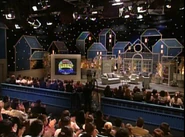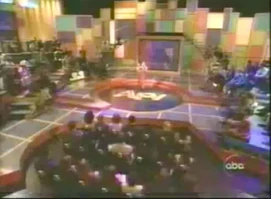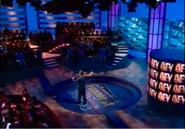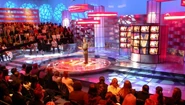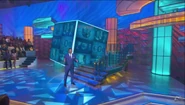Theme Music[]
In the 1989 pilot/special, an instrumental version of "The Funny Things You Do" is heard, and no vocals were used.
On January 14, 1990, vocals from Jill Colucci were added to "The Funny Things You Do".
On February 2, 1997, "The Funny Things You Do" was rerecorded, featuring Peter Hix (who previously performed the theme song for America's Funniest People) and Terry Wood on lead vocals, along with several backup vocalists.
On January 5, 1998, the theme changed back to an instrumental version, featuring a horn section, and an electric guitar, and no vocals were used.
On October 11, 2015, the theme was rerecorded with the same horn section, the electric guitar was removed, and was replaced by piano and saxophone parts. The 2015 theme combined "The Funny Things You Do" with the 1998-2015 theme.
Opening Credits[]
In the 1989 pilot/special, a blue sky with clouds were used while yellow stars zoom in, followed by the show's logo zooming in, and exiting to the upper right. To show the upcoming clips, an animated purple TV set was used. Followed by the show's logo again before revealing a shot of the set, followed by Saget's entrance.
On January 14, 1990, a mixed red, white, and blue-like background with a giant camera lens was used while animated stars and stripes zoomed out of the lens. Then, the show's logo zooms forward and exits forward on an angle. Following that, a silver screen was used to show the upcoming clips. A stars and stripes effect is used to transition from each upcoming set of videos upon the start and ends of the chorus. This is followed by the show's logo again, which leads into a skit about people watching America's Funniest Home Videos before revealing the set, which leads to a wall transition, followed by Saget's entrance with the introduction of Ernie Anderson, and substitute announcer Charlie O'Donnell. The skits were dropped in Season 6.
Variants:
- On the 1991 CBS/Fox Video release The Best of America's Funniest Home Videos, "THE BEST OF" banner can be seen beneath it.
- For $100,000 shows starting in Season 3, a red banner with the text reading "$10,000 Classics" can be seen.
- On this skit of Season 2, Episode 13, Jill Colucci appeared on camera with her band performing "The Funny Things You Do" in a recording studio, and then, the camera zooms in on the TV to reveal Saget's entrance with Charlie O'Donnell's introduction.
- On this skit of Season 3, Episode 9, Ernie Anderson the show's announcer and the voice of ABC appeared on camera introducing the first $100,000 show of the season in his booth while the camera pans through the wall. followed by the satellite city introductions, and Saget's entrance.
- On America's Funniest Home Videos: An Inside Look, the logo is smaller. "AN INSIDE LOOK" can be seen next to it.
- To celebrate the show's 100th episode in 1993, "100th EPISODE CELEBRATION" can be seen on a red banner.
On February 2, 1997, a computer animated segment showed the words, "Home Videos Sunday" on a black background and a multicolored circle. Then, behind the space background on the window is a CGI family emerging from the red couch while watching the TV. Then, the show's logo is plastered on the same multicolored circle. The upcoming videos are now shown on an animated widescreen silver TV set. The stars and stripes effect have changed to red, white, and blue streamers, and white confetti. Followed by the show's logo again before revealing the set, followed by Saget's entrance.
- In syndicated versions, the Home Videos Sunday and CGI family are not there, rather the intro starts on a black background, the logo animates in, and it starts as normal from there, with the widescreen silver TV set.
On January 5, 1998, the space background was replaced with a multicolored background with past AFV clips which was shown from the Saget era, and the words "America's Funniest Home Videos", as well as "AFV" flying around. Then, the show's logo types itself out, followed by the letters "AFV" coming forward and zooming off in different directions. During that period, the upcoming clips were shown on the same background, with an animated widescreen with two wavy borders. In 2001, cartoon sound effects were changed to live-action audio. For $100,000 shows, computer-animated falling dollar bills were used in the background.
On September 27, 2002, the clips and wavy borders shown during the intro is replaced by a small blue glowing TV set.
On September 28, 2003, the same intro was used, except to show the upcoming clips, the clips were shown added in the background, along with a small blue glowing TV set used.
On September 26, 2004, a bright orange colored background was used as the "AFV" letters dropped down as one. The same small blue glowing TV set was used for upcoming clips.
On October 2, 2005, the blue TV set only glowed when it was zooming in. When it showed the clip, it was normal. This opening was also shown without the clips and was only used during the end of the 16th season in 2006.
On October 1, 2006, the blue TV set's screen became wider.
On October 7, 2007, the blue TV set sparkled, its hue became lighter and the screen was more stretched. When alternating videos, the screen turned gray at times.
On October 5, 2008, flying stars were added to the bright orange background.
On October 2, 2011, the background screen was changed to blue and green. Also, the past clips in the background were removed and changed to squares.
On October 7, 2012, a silhouetted applauding crowd is shown as the letters "AFV" appear on a flashing blue-lit background. Then, the logo is shown on an overhead camera shot of the set.
When America's Funniest Home Videos celebrated its 25th anniversary on October 12, 2014, the letters "AFV" now appear on a square background with the silhouetted applauding crowd. Now, the logo is silver sparkled with the number 25 next to AFV.
On October 11, 2015, the background screen was changed to purple with white lines. Also, the logo became purple and yellow, and the number 25 was removed.
In 2021, the logo became black and yellow instead of orange and purple.
Sets[]
The AFHV set has seen a lot of changes during its run.
Saget Era[]
In the Saget era, the set consisted of a typical living room, which is made of furniture, such as a cabinet, table, lamp, couch, and a television set. Both sides consisted of large video monitors. On $100,000 shows, the satellite cities were joined on the right video monitor. In the background, there was a neighborhood skyline, which can be seen behind the audience. there's also a house over the bleachers, where the skits are at the beginning of the show, where silent actors are watching America's Funniest Home Videos on their television set.
Pilot/special (1989)[]
- In the 1989 pilot/special, co-hosted by Bob Saget, and Kellie Martin, the set consisted of two video walls of 16 monitors on both sides of the living room. There was also a large monitor in the middle of the living room set. The two entrance doors were shown on both sides, one for Saget, and one for Martin. A table and chair can be seen next to the entrance door. Also, the TV set did not appear in the living room. The skyline background lights were blue, and the poster sign consisted of a picture of a person filming, while the show's logo was at the bottom. The poster sign was also located in the back of the audience area. The blue and white striped wallpaper was darker, and the carpet was pinkish red.
- This was a one-off special that aired on ABC on November 26, 1989.
- This set, along with with the two others used in the Saget era were designed by Bill Bonhert.
Seasons 1 and 2 (1990-1991)[]
- When America's Funniest Home Videos premiered as a regular series on ABC on January 14, 1990, with Bob Saget hosting solo, the entrance door was shown on the left side, instead of the right side, and the TV set was added to the furniture of the living room set. The blue and white striped wallpaper had become even brighter, and a bay window was added to the living room set (with the roof looking different from the pilot set). The two large monitors on both sides were now large single units. The skyline background lights became purple. The carpet became dark blue, and no yellow lampposts were used on the audience area. On later episodes of Season 2, yellow lampposts were added to the audience area.
Season 3 (1991-1992)[]
- On September 22, 1991, at the beginning of Season 3, Bob Saget had a haircut, and the blue and white striped wallpaper was gone. The wallpaper gained a light blue color scheme with a pattern of dots. The carpet became a lighter blue color, and the window in the middle was small. The skyline background became light blue, with a sunset gradient color.
Seasons 4-Mid-Season 8 (1992-1997)[]
- On September 20, 1992, at the beginning of Season 4, and ran until Mid-Season 8, the dotted wallpaper was removed from the set, so the set consisted of three glass windows in the middle, and the picture frames were removed from the set; the set now had a translucent look to it. The skyline background had become even brighter. On the 4th season premiere, which aired on September 20, 1992, Bob Saget asked the audience: "How do you like our new set?". Through each season that passed, minor alterations to the set occurred, such as the color of the skyline, different positions of the background houses, and different lighting. The last time this set was used was Season 8 Episode 16, which aired January 12, 1997.
Final Set, Mid-Season 8 (1997)[]
- On February 2, 1997, by the end of Saget's run, the skyline background lights became black, and the star lights became white. The carpet became gray, and lightened up trees were added to the backstage area; aside from that, the set retains the basic 1992 design. This set remained in use until Saget left the show on May 18, 1997.
Fuentes/Fugelsang Era (1998-1999)[]
- On January 5, 1998, with Daisy Fuentes and John Fugelsang being named the new hosts of the program, the set was completely overhauled. It has "AFV" written on it, which was only used during the end of its 9th season and was used in its 10th season. There are also multi-colored square walls. There was also a dollhouse. In addition to the set, there is a large monitor behind the center circle stage, which is complete with two staircases on both sides. In its early years before the Bergeron run, the monitor was not on the circle floor. At the top of the stairs, there are a couple of square doors where Fuentes and Fugelsang both make their entrances, when it was shown to be used in in their very first season in 1998, when it was recycled when they both walk downstage with audience stairs in their second and very last season until 1999. The audience seating can now be seen on the left side, the right side, and behind the stage. Also, there are comfy yellow couches and lounge chairs for some audience members to sit in. These people had to stand up as finalists in this set and it was used in $100,000 shows at the time, but the set was a little too small prior to it and to this one. This set remained in use until Fuentes and Fugelsang both left the show in 1999.
Bergeron Era[]
Variants[]
First set (2001-2003)[]
- On February 3, 2001, when Tom Bergeron took over as host and AFV resumed being a regular series, the square walls were removed. The set consisted of a center stage that has a darkening color and featuring the show's logo in the middle. The audience seating was added to the left side, back left side, and behind the stage. There was also a cubic-like video screen next to the stage. There was also cylinder-like pillars that glowed purple. These people had to sit to stand up as finalists in Tom's first two seasons, while they all stand up as finalists since 2003 and was only used in season 13 which is the last season to use the 2001 set in 2003, which was only shown on the Battle of the Best in 2002. There was also a dollhouse next to the video wall.
Second set (2003-2006)[]
- On September 28, 2003, the set was enhanced, with the center stage consisting of lights, and the words "AFV" replaced the show's title in the middle. The pillars became blue, sometimes other colors for certain occasions. The set is similar to the old 2001-2003 set; The video wall consisted of a curvy-like video wall screen. They were also curved light borders that were hanging above the set. The floor became blue with circles, but the dollhouse was still seen next to the video wall. The set was well known for the 1998 and 2004 intros when the set was last used until 2006.
Third and Final set (2006-2015)[]
- On October 1, 2006, a bar/lounge was added to the front row of the studio audience area. The center stage consisted of an LED screen in the middle. The monitors on the video wall were changed to a giant LED screen. When Tom makes his entrance, he was in a silhouette wall with lights. By the end of Bergeron's era, the silhouette wall was removed in 2010, was replaced by a glass sliding door which was used since 2010 when the show converted to high definition, and the people who stand as finalists were all shown in the set in three $100,000 episodes from seasons 17 to 23 when it was last used in 2013 and was used with a gate and rock stone when these people stand as finalists when it was used from 3 $100,000 shows to 2 $100,000 shows and it was used from the last two seasons Tom Bergeron hosted the show until 2015. It was also shown in the 2015 set when Alfonso Ribeiro announced the finalists for the $100,000 video in season 26 since 2016 (see his current set below). In 2009, the show introduced their "Funny Since 1989" campaign. This set remained in use until Bergeron left the show in 2015.
Ribiero Era[]
Current set (2015-present)[]
- When Alfonso Ribiero took over as host in 2015, the swurvy curved like-video wall screen was replaced by a giant LED video cube, complete with a staircase on the side. The circle was removed from the set, so the audience can see it more visible, and the floor's wallpaper became an outlined checkerboard. When Ribiero made his entrance at the beginning of the show, he enters his studio by entering an elevator style door, and walking downstairs by going straight to the set.





